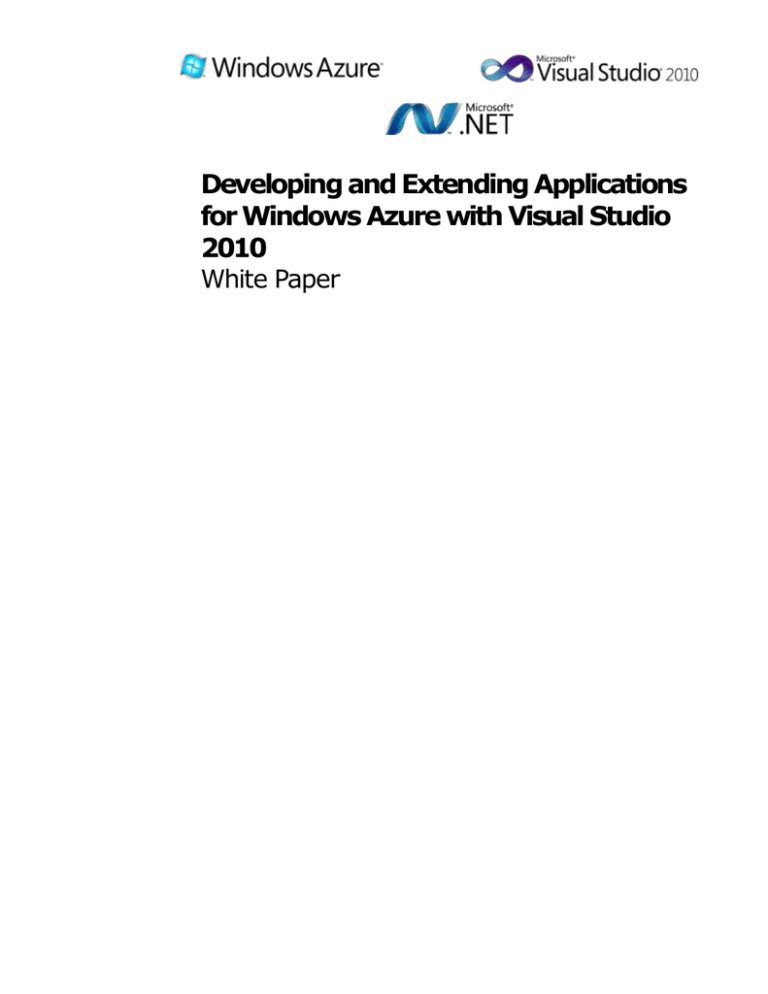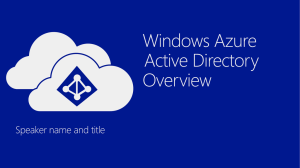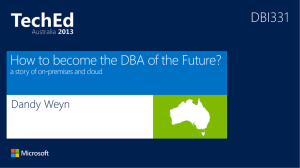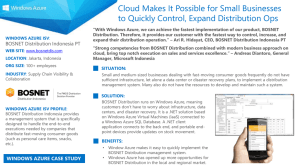
Developing and Extending Applications
for Windows Azure with Visual Studio
2010
White Paper
Published: February, 2011
Table of Contents
Introduction............................................................................................................. 1
A Case for Cloud Computing ...................................................................................... 2
SaaS, IaaS and PaaS ............................................................................................ 3
Introducing Windows Azure ....................................................................................... 5
Hello Cloud! ............................................................................................................. 6
Exploring the Green Fee Broker Sample Application .................................................. 6
Developing for Windows Azure with Visual Studio 2010 ............................................. 7
Deploying to Windows Azure ................................................................................ 14
Conclusion ............................................................................................................. 19
About the Author: ............................................................................................... 20
Appendix ............................................................................................................... 21
Windows Azure Compute Service .......................................................................... 21
Windows Azure Storage ....................................................................................... 22
Security in the Cloud ........................................................................................... 22
Developing and Extending Applications
for Windows Azure with Visual Studio
2010
White Paper
Published: February, 2011 (style = Published)
For the latest information, please see http://msdn.microsoft.com/vstudio
Introduction
Organizations of all sizes are under increasing pressure to do more with less.
Providing solutions that meet these demands while reducing operational costs and
maximizing efficiency is not just highly desirable, but has become a necessity.
What’s more, providers of information technology solutions are expected to be
able to guarantee service delivery while dynamically growing with the needs of
the business and at the same time, minimizing costs.
This is a difficult proposition. Organizations must be very careful in selecting
infrastructure and a platform that delivers both development and operational
productivity. These choices must be able to meet both current and future needs
of the business. However, planning investments around unpredictable platform
and infrastructure costs can be daunting.
In response to these challenges is the advent of a disruptive technology known as
cloud computing. Wikipedia defines cloud computing as the “natural evolution of
the widespread adoption of virtualization, service-oriented architecture and utility
computing. Details are abstracted from consumers, who no longer have need for
expertise in, or control over, the technology infrastructure ‘in the cloud’ that
supports them.”
Windows Azure is a Platform as a Service (PaaS) cloud computing offering which
forms the bedrock of Microsoft’s Azure Services Platform. PaaS offerings focus on
enabling customers to develop, deploy and operate applications without needing
to focus on underlying infrastructure or servers or ongoing operations
management.
Developers write applications for Windows Azure using Microsoft .NET, a
comprehensive framework for building desktop, mobile, web and cloud
applications and services. While Windows Azure supports several non-Microsoft
programming languages including PHP, Java and Ruby, Microsoft .NET offers
developers a number of language choices, – the most common being Visual C#
and Visual Basic for writing applications in .NET as well as ASP.NET, Microsoft’s
premier framework for building web applications. These applications can be
written with a simple text editor and command line tools for managing
compilation, however, Visual Studio 2010 is the premiere integrated development
Developing and Extending Applications for Windows Azure with Visual Studio 2010
1
environment (IDE) for writing .NET applications for deployment both on-premise
and in the cloud.
A Case for Cloud Computing
Estimating and provisioning infrastructure is expensive because it is difficult to
predict the elastic needs of an application or service over time. Even when
engaging experts to conduct capacity planning, the needs of the business can
expand and contract abruptly as demands for products and services are often
elastic. The result is that often times, companies are faced with the choice to
either go small or go big on their infrastructure purchases. The former introduces
the very real risk of service delivery failure, and the latter can be prohibitively
expensive.
As shown in Figure 1, many companies typically land somewhere in the middle,
which means a never ending procurement process and ballooning expenses with
server after server seemingly disappearing into a black hole. This is not only a
drain on operating budgets from a hardware perspective, but provisioning and
deploying servers is time consuming and expensive and detracts from the ability
to deploy resources to more tangible revenue generating activities.
Figure 1: The perpetual mismatch of supply and demand of IT capacities.
Does an organization need to over-invest in platform and infrastructure to ensure
that they are able to scale to the ever changing needs of the business? What is
the cost of excess capacity that goes unused for any given period of time? Worse,
given increasingly aggressive budgets, what are the consequences to brand
identity and customer experience when under-investing and introducing the risk
of failing to meet the operational needs of the business?
Cloud computing is revolutionary because it delivers the consumption of
infrastructure, platform and software as a utility, or a service to the masses.
Developing and Extending Applications for Windows Azure with Visual Studio 2010
2
With cloud computing, companies who are experts at providing infrastructure,
platform and packaged software leverage massive investments in data centers
and redundant infrastructure to provide these capabilities as commodity services
that your company can consume as needed. Just as with your household utilities,
your company extends an application to just “plug in” to the cloud, taking
advantage of the massive scale and redundancy for a pre-defined, metered or
per-user rate. The result is a much better alignment of IT capacity with the elastic
needs of the business as shown in Figure 2.
Figure 2: Alignment of capacity with the elastic needs of the business.
In this white paper, you’ll learn how to “plug in” to Windows Azure with Visual
Studio 2010 by walking through the process of taking an existing application and
extending it for the cloud.
Before we get started, let’s discuss the three most common ways that cloud
providers, including Microsoft package their cloud computing products.
SaaS, IaaS and PaaS
The promise of cloud is choice, and there are a number of companies that provide
a variety of cloud services packaged either as Software as a Service (SaaS),
Infrastructure as a Service (IaaS) or Platform as a Service (PaaS) as summarized
in Figure 3.
Developing and Extending Applications for Windows Azure with Visual Studio 2010
3
Software as a Service (SaaS) is exactly what it sounds like. Companies build
commercial software packages and make them easily available on the Internet.
SaaS can deliver significant savings to organizations that want to take advantage
of packaged offerings such as customer relationship management (CRM) software
packages allowing greater access to that software without worrying about
“system requirements” or other pre-requisites.
Infrastructure as a Service or (IaaS) is a type of cloud service that offers the
management, hosting and provisioning of computer infrastructure. Instead of
buying physical hardware such as servers and PCs, installing operating systems,
racking servers and connecting to networks, users of IaaS merely consume
instances of operating systems that are made readily available at their fingertips.
While SaaS and IaaS have their place in cloud computing, for many organizations,
only highly customized solutions will do. Platform as a Service or (PaaS) abstracts
beyond IaaS and provides a platform on which to build custom software enabling
organizations to develop, deploy and operate applications without needing to
focus on underlying infrastructure or servers or ongoing operations management.
With PaaS, you don’t focus on infrastructure at all. You write your applications
against a given platform such as .NET and simply deploy your software to a
logical container. This eliminates cumbersome deployment chores and simply
makes your application available for use at whatever level of scalability and
redundancy you require.
Microsoft offers businesses and developers the greatest breadth of choice as they
engage in cloud computing because they are the only company that delivers
across SaaS, IaaS and PaaS product offerings. Microsoft further differentiates
itself from Amazon, Google or any other competitor in a fundamental way by
providing customers the flexibility to use on-premises technology, cloud
technology or both, as part of Microsoft’s software-plus-services (S+S) strategy.
In this paper, I will focus your attention on Windows Azure which at its core
provides you with the .NET platform as a service (PaaS) on which to build
customized and highly dynamic applications at Internet scale.
Figure 3: Common products offered by cloud providers.
Developing and Extending Applications for Windows Azure with Visual Studio 2010
4
Introducing Windows Azure
Windows Azure is Microsoft’s operating system for the cloud and forms the
bedrock of Microsoft’s Windows Azure Platform. As a PaaS offering, Windows
Azure abstracts the details of hosting, runtime components and management
which helps you focus your time and resources on building software that delivers
business value.
In addition to providing an operating system for the cloud, the Windows Azure
Platform provides additional cloud products including AppFabric, SQL Azure, CDN
and MarketPlace. Each of these technologies enrich the development experience
and reach of applications deployed in Windows Azure, the enterprise, on premise,
in the cloud, or any combination thereof.
AppFabric is an integrated set of services for hosting, managing, connecting
and securing your applications and third-party applications that are deployed
both on-premise or in the cloud. It allows you to connect and scale your
applications whether they run on-premise, in the cloud or both.
SQL Azure is a cloud-based relational database service (RDBMS) built on SQL
Server technologies. It provides many of the capabilities of SQL Server with
the ease of being hosted by Microsoft in the cloud. With SQL Azure, you just
point your application to the database and SQL Azure takes care of the rest.
CDN is a Content Delivery Network that geographically distributes copies of
frequently used data such as files, images, and videos so that they are as
close as possible to users of your applications that consume this media. This
helps ensure that the content your application needs can be accessed as
quickly as possible.
Marketplace provides one-stop-shopping for discovering data feeds and other
applications that can be used to bring your applications to market more
quickly and easily. For example, DataMarket provides data feeds that you can
integrate with your application, saving you the time and expense of building
or finding this data on your own.
While there are many exciting and useful features in the Windows Azure Platform,
this paper will focus on gaining a better understanding of Windows Azure and how
easy it is to build new and extend existing applications for Windows Azure with
Visual Studio 2010. You’ll learn how together they provide a development, run
time, and management environment that supports the ability to develop, deploy
and run your applications at Internet-scale.
To learn more about the Windows Azure Compute Service, Windows Azure
Storage and Security in the Cloud, refer to the appendix of this paper.
Developing and Extending Applications for Windows Azure with Visual Studio 2010
5
Hello Cloud!
Exploring the Green Fee Broker Sample Application
Let’s start by exploring a start-up company who has recently begun experiencing
growing pains.
Green Fee Broker allows golfers to play their favorite courses at the lowest
possible rate. Golfers install the “My Green Fee Broker” application on their smart
phone, pick from a list of participating golf courses, and subscribe to alerts when
a registered course publishes an available tee time. If a golfer is interested in
submitting a booking offer, they can either submit an offer directly from their
smart phone, or login to My Green Fee Broker Online, a website that also provides
the ability to submit a booking request to the Green Fee Broker Service from any
PC. From there, Green Fee Broker Service goes to work to search for the lowest
possible published rate available, books the course, and notifies the golfer of his
or her tee time via a smart phone alert and/or an e-mail notification.
The great thing about the Green Fee Broker Service is that it is always available.
It exposes a web service API that can be consumed either by the My Green Fee
Broker smart phone application orGreen Fee Broker online (as well as branded
Web properties for specific golf courses) which allow golfers to use the Green Fee
Broker Service API to submit a booking request on-demand or in response to a
smart phone alert.
However, the greatest strength of this product is quickly becoming its biggest
liability. The success of marketing campaigns and word of mouth has really put a
strain on the company’s ability to ensure that core engine that exposes the API
for managing customer requests and enrolling new customers remains available –
the volume of traffic to the Green Fee Broker Service API has simply outpaced the
abilities of the current infrastructure and the occasional application crashes
threatens the brand that the start-up has worked so hard to build. Realizing that
adding more and more servers, and dealing with the complexities of configuring
web farms and clusters is simply not an option, the company looks to the cloud
for a solution.
One option would be to move the Green Fee Broker Service from the on-premise
facility to an IaaS provider. While this is certainly a more attractive option than
the current situation, installing all of the requisite platform components and
deploying the service to multiple hosted instances really takes away from the
focus of Green Fee Broker which is to simply always be available. Moreover, the
time and expense managing each of the instances independently could be better
re-deployed to activities that enhance the product directly.
After some internal discussion, the development management team decides that
Green Fee Broker Service API is perfect for deployment to Windows Azure. At its
core is a brokering engine that is exposed as a web service over HTTP to any
number of consumers who leverage the API and the Broker Service must not only
Developing and Extending Applications for Windows Azure with Visual Studio 2010
6
be always available, but be able to scale to the increasing demands of this
successful start-up. Rather than continuing to fall into the staircase trap depicted
in Figure 1, Windows Azure provides Green Fee Broker with the tools to align
capacity with the precise needs of its customers as originally discussed in Figure
2.
Since the team is already writing applications on the .NET Framework, the
learning curve is minimal and they get to leverage the tools and skills they
already have with little to no changes to the code.
In addition, Windows Azure does not require big expenditures up front, so capital
expenses can be converted to operational expenses. Since the start-up must only
pay for what they use, they gain the flexibility and ability to test new ideas
without having to make big, up-front investments in infrastructure which fuels
innovation. All of these benefits of Windows Azure allow the company to focus on
building and innovating on the product on the same platform and with the same
tools they’d build any other applications for .NET.
Developing for Windows Azure with Visual Studio 2010
Visual Studio is an integrated development environment (IDE) for developing
applications on Microsoft’s .NET Framework. Visual Studio 2010 provides a
premier toolset for developing, testing, and maintaining applications for both onpremise deployment and the cloud. I’ll show you how to extend an existing
application for deployment to Windows Azure with Visual Studio by adding a
Windows Azure Project and associating it with a web role. I’ll then demonstrate
how simple Visual Studio 2010 makes testing a cloud application locally and
packaging it for deployment to Windows Azure.
Exploring the Green Fee Broker Service
The Green Fee Broker Service is a web service written with Windows
Communication Foundation (WCF). WCF is a messaging framework that is part of
the .NET Framework that allows you to share modular units of functionality called
classes with other applications by exposing these classes with special functions
known as operations. These operations can be executed by applications on the
same machine, by different machines in the same network or on machines on
completely different networks altogether. The Green Fee Broker Service exposes
key functionality over HTTP including operations for registering a new golf course,
retrieving a list of participating golf courses and allowing golf courses to publish
available tee times.
Visual Studio organizes classes into special containers called projects, which are
in turn grouped into a special container called a solution. A solution can have one
or more projects which includes one or more classes. After you’ve written code
inside classes, you build a solution which conducts a series of verifications to
ensure that the code you’ve written is valid and follows the rules of the language.
If all goes well, each project will be packaged into an assembly which can then
Developing and Extending Applications for Windows Azure with Visual Studio 2010
7
either be executed directly or called by a different assembly that is part of a
project (in the case of a web service, a client sends messages to the assembly
over a communication channel to execute it).
Inside the GreenFeeBroker solution is a Visual Studio 2010 project called
“BookingService”. In this case, the “BookingService” project uses the WCF Web
Application Template which provides the basic files for building a WCF web
service. In its simplest form, the WCF Web Application project consists of two files
as shown in Figure 4:
BrokerService.svc contains the implementation of the operations
mentioned above.
Web.config contains basic configuration for hosting the web service.
Figure 4: The Broker Service project in Visual Studio 2010 Solution Explorer.
The Green Fee Broker service exposes its functionality using SOAP over the HTTP
protocol. SOAP makes it possible to use familiar object-oriented techniques when
developing the service and automates the means by which the service exchanges
and processes XML messages over the Internet.
It would be tempting to write the code that implements the BrokerService
operations directly in the BrokerService.svc file, however, the Green Fee Broker
application was developed with separation of concerns in mind such that each unit
of functionality is independent of the other but work together to get a job done.
As such, the project contains additional classes which define a golf course (the
“Course” class), isolate business rules for working with courses into a class called
Developing and Extending Applications for Windows Azure with Visual Studio 2010
8
“CourseManager” and group all data operations into a common class called
“DataServiceAgent”.
Separation of concerns is an important design principle when developing for both
on-premise and cloud because it allows you to focus on slices of functionality and
makes for software that is easy to understand and maintain. What’s more, when
developing applications that will run both on premise and/or in the cloud, the
ability to manage state and make deployment decisions is significantly simplified
by mapping logical layers onto physical tiers as with web roles, worker roles and
storage services.
Extending the Green Fee Broker Service for the Cloud
Creating new applications and services for Windows Azure with Visual Studio 2010
is very simple. Believe it or not, since the service was written in .NET with Visual
Studio for on-premise hosting, with the exception of a little configuration, it is
already ready to be hosted in Windows Azure.
To demonstrate this, let’s take the existing Green Fee Broker application and
enable it for Windows Azure1.
Creating a Windows Azure Project
The first thing you will do when developing or extending an application for
Windows Azure is add a Windows Azure Project to your Visual Studio 2010
solution. Just as the WCF Service Application template provides everything you
need for creating a WCF web service, the Windows Azure Project template
provides the container and configuration required to package a common Visual
Studio 2010 solution for Windows Azure. To get started simply add a new
Windows Azure Project to the GreenFeeBroker solution, provide a name for the
project, and click OK (Figure 5).
1
In addition to Visual Studio 2010, you must install the Windows Azure Tools for Microsoft Visual Studio version 1.3 which includes the
Software Development Kit (SDK) and is available here: http://msdn.microsoft.com/windowsazure/cc974146.aspx. If you are running a
32-bit version of Windows 7, or are running Windows Vista or Windows Server 2008, there are some hotfixes you will want to install as
well.
Developing and Extending Applications for Windows Azure with Visual Studio 2010
9
Figure 5: Adding a Windows Azure Project in Visual Studio 2010
Visual Studio 2010 presents you with a list of roles that will tailor the template to
the kind of application you are building. In this case, since we want to enable the
BrokerService for Windows Azure we’ll choose the WCF Service web role as shown
in Figure 6.
Figure 6: Choosing the WCF Service web role.
The Windows Azure Project makes it simple to configure the BrokerService project
for Windows Azure by providing a user interface for associating projects with a
role. You can simply right-click on the Roles icon to select an existing project or
create a new one after which the project you added will be associated with the
role as shown in Figure 7.
Developing and Extending Applications for Windows Azure with Visual Studio 2010
10
Figure 7: The result of associating a new or existing project to a Windows Azure
Project.
To make working with the solution as easy as possible, right-click the
GreenFeeBroker.Cloud project and select “Set as Start Up Project.” This ensures
that when you test your application locally, the project is initialized correctly in
the Development Fabric (which is covered shortly).
There are a number of configuration options when deploying your application or
service to Windows Azure and you can set these options by right-clicking on the
associated role (in this case the BrokerService shown in Figure 7) and selecting
properties.
The most common settings include how many instances you would like Windows
Azure to allocate for you upon deploying your application as well as the size of the
virtual machine your deployment will target. These choices are among the most
important because they will have a direct effect on application performance,
availability, scalability and cost.
Figure 8 shows various configuration options including the type of virtual machine
you want to use and the number of instances you’d like Windows Azure to
allocate to your application. In this case, I’ve configured 4 Small instances. Don’t
worry if you aren’t sure what settings to choose at first. As you learn more,
chances are your needs can and will change and the nice thing about Windows
Azure is that you can change your mind!
Developing and Extending Applications for Windows Azure with Visual Studio 2010
11
Figure 8: Windows Azure web role configuration options.
The Settings tab allows you to set configuration string/value pairs for things like
database connections, paths for logging, etc. Visual Studio 2010 provides a great
development experience by allowing you to set up configurations for both testing
locally and running in the cloud.
Local Testing with the Development Fabric
Visual Studio 2010 provides full application lifecycle management capabilities for
applications designed to run both on-premise and in the cloud. When developing
applications for Windows Azure, the development lifecycle is consistent with best
practices for Application Lifecycle Management (ALM).
As shown in Figure 9, you develop and test locally with Visual Studio 2010 and
development run-time tools for emulating both Compute and Storage. You then
deploy to a staging environment provided in the cloud by Windows Azure where
you perform testing before finally pushing your application or service to
production.
Figure 9: Windows Azure Application Lifecycle Management.
Developing and Extending Applications for Windows Azure with Visual Studio 2010
12
Visual Studio 2010, together with the Windows Azure SDK, includes a package for
doing local development, testing and debugging called the Development Fabric.
The Development Fabric consists of two main components: the Compute Emulator
and the Storage Emulator.
The Compute Emulator allows you to build, deploy and test your applications for
Windows Azure in your local development environment. You might think of the
Compute Emulator as the equivalent of the web hosting capabilities inside Visual
Studio that provides an Azure hosting and debugging experience that emulates
IIS. Visual Studio provides a seamless development, testing and debugging
experience that allows you to interact with your application running in the
Compute Emulator directly from within the IDE.
For simulating the storage service, the Windows Azure SDK includes a storage
service emulator intended for local development and testing called the Storage
Emulator. The Storage Emulator provides a development experience that is
identical to working directly with Azure storage at the API level. When working
locally, Visual Studio will automatically provision local storage for you using any
recent version of Microsoft SQL Server including SQL Server Express Edition. This
allows you to write code that uses the same storage APIs regardless of whether
the code is running locally or in the cloud. However, please be aware that the
Storage Emulator is for development purposes only and should never be used for
production scenarios.
In fact, with Visual Studio 2010, interacting with the Development Fabric is simply
a matter of running your application from the IDE!
When you start your solution within Visual Studio 2010, you will notice some
feedback in the lower left-hand corner of the IDE indicating that Visual Studio is
both packaging and deploying your application to the Development Fabric
including application code to the Compute Emulator and table, blob or queue
instructions to the Storage Emulator (please refer to the appendix for more
information on the Windows Azure storage service).
At this point, the application is hosted and ready for testing. Visual Studio 2010
will automatically open a browser window with the base address of your
application or service and put the application into debug mode which allows you
to interact with the application and conduct any troubleshooting with the code in
an interactive manner.
In addition, any instructions for creating tables, blobs or queues will be executed.
These instructions can be placed in a global file which will allow for the code to be
executed during various stages of the application lifecycle including start up.
To see the active deployment, look for the Windows Azure icon in your task
taskbar, right-click it and select “Show Compute Emulator UI”.
Developing and Extending Applications for Windows Azure with Visual Studio 2010
13
The Windows Azure Compute Emulator UI provides visibility into the application’s
status and health. You can start and stop the application as well as continue to
monitor it visually. Notice in Figure 10 that there are four virtual instances of the
application, just as we selected when we configured the BrokerService Windows
Azure Project.
Figure 10: The Windows Azure Compute Emulator UI.
At this point, with the BrokerService hosted, you can test it as you normally
would and make any modifications necessary before deploying to Windows Azure.
Deploying to Windows Azure
Once you have developed and tested your application locally, you are ready to
deploy to Windows Azure!
Packaging Your Application with Visual Studio 2010
The first step to deploying your application to Windows Azure is to create a
deployment package. Visual Studio 2010 simplifies this process by automating the
creation of the package for you when you right-click on the Windows Azure
project and select “Publish.” As shown in Figure 11, you can choose from two
approaches:
Create Service Package Only. This creates a package file containing your
application and a configuration file containing all the settings that you
Developing and Extending Applications for Windows Azure with Visual Studio 2010
14
specified for provisioning, deploying and running your application. You can
then upload your package via the Windows Azure Management Portal.
Deploy Your Windows Package to Windows Azure. This automates packaging
and deploying your application into one easy step.
The second option requires that an X.509 certificate be installed on the local
development machine and uploaded to the Windows Azure Management Portal to
ensure that only authorized packages are being deployed.
Figure 11: Windows Azure packaging and deployment in Visual Studio 2010.
I’ll show you how to deploy your application using the first method to give you
some familiarity with the Windows Azure Management Portal. As you gain
experience with setting up and managing Windows Azure deployments, the fully
integrated deployment experience that the second option provides within Visual
Studio will become useful, particularly when re-deploying existing applications or
services.
To package your solution, click OK and you will instantly see Windows Explorer
open to the location of the package that Visual Studio 2010 created. Figure 12
shows the two files that are created.
Developing and Extending Applications for Windows Azure with Visual Studio 2010
15
Figure 12: Service Package and Configuration files for deployment.
Deploying Your Application via the Windows Azure Management Portal
The Windows Azure Management Portal provides everything you need to manage
your Windows Azure Platform services, including compute roles, storage, CDN,
AppFabric and Marketplace services.
When you log into the portal (provided you’ve set up a Windows Azure
account),you will have the option to create a new Hosted Service and a new
Hosted Storage Account. These options allow you to define a compute and
storage deployment, which you must do before you deploy your application and
corresponding storage requirements to Windows Azure.
The process for deploying an application or service to stage or production is
identical, and you must choose one of the two when first deploying your
application to Windows Azure.
To deploy the BrokerService, after clicking on “New Hosted Service” as shown in
Figure 13, a window appears which you populate in order to prepare the hosting
environment. After you select a subscription account, you provide a name for the
service that you’ll use to easily identify the application in the Windows Azure
Management Portal. You also must specify a unique URL prefix as this will become
part of the fully qualified URL that will be used to access your application or
service, in this case the BrokerService WCF web service.
Developing and Extending Applications for Windows Azure with Visual Studio 2010
16
Figure 13: Windows Azure Management Portal New Hosted Service provisioning.
You will also notice the ability to select affinity groups, which allow you to make
explicit requests for where your Compute and Storage applications will be located.
For example, since the Windows Azure data centers are geographically distributed
worldwide, to optimize performance it may be a good idea to ensure that your
application hosted in Compute is as close to your data hosted in Storage as
possible. Affinity groups are the tool for accomplishing this.
Deployment options include whether you want to deploy your application to the
stage environment, the production environment, or not at all. Keep in mind that
you will be billed the same regardless of whether you choose stage or production.
The main benefit of having two environments is the ability to test a version of an
application before it is live in production, and this is particularly useful when
testing two versions of an application side by side.
You can select anything you’d like for the Deployment name, but I recommend
adopting a simple versioning standard that you can use as a label. This will make
it easy to identify and track and recognize the different versions of your
applications and services as you move them from stage to production.
Lastly, providing the path to the package and configuration files that Visual Studio
created for you by clicking “Browse Locally…” and clicking OK will begin the
deployment and provisioning process.
The management experience that is created based on your choices will show you
that four instances of compute (in this case, 4 “Small” VMs) are being allocated
for v1 of the BrokerService. The status of each instance will cycle through
waiting, creating, and starting the compute instances that will host the
Developing and Extending Applications for Windows Azure with Visual Studio 2010
17
application. This takes a few minutes, however when you consider how long it
would take to get four traditional servers or virtual machines up and running in a
load balanced environment and fully deployed with your application, the speed
and ease of accomplishing this with just a few simple clicks is quite remarkable!
As shown in Figure 14, when all instances are ready the logical service will show a
status of Ready. Clicking on the label will provide metadata about the deployment
including the date created, number of instances allocated, along with the DNS
name to the publically available URI which provides a single logical load balanced
endpoint to the BrokerService.
Figure 14: The BrokerService ready for consumption.
Testing in Windows Azure
At this point, you can test the service just as you would in a traditional onpremise testing environment.
To browse to the service, simply click on the DNS name shown in Figure 14 which
will launch your browser. Add the BrokerService.svc file name at the end of the
URL in the address bar and you should see a hosting page appear indicating that
the service is ready to be consumed. I always recommend conducting postdeployment verification testing or “smoke testing” to ensure that the service is
hosted properly and able to perform common, routine functions.
You can use the WCF Test Client that ships with Visual Studio 2010 to test the
service in Windows Azure staging or production just as you would locally against
the Storage Emulator.
Developing and Extending Applications for Windows Azure with Visual Studio 2010
18
Promoting to Production in Windows Azure
Once you’ve deployed your application to Windows Azure, you can instantly
deploy your application to production by selecting the “Swap VIP” option in the
Azure Management Portal. If you don’t have an active production deployment,
then your staging deployment will be promoted to production. From this point on,
you can use the production URL, in this case http://brokerservice.cloudapp.net.
Managing Your Application in Windows Azure
You will use the Windows Azure Management Portal not only for deploying, but
also for managing your Windows Azure applications and services.
When you are ready to deploy a new version of the application, you can follow the
same steps outlined above which will result in a different version deployed to
physically separate nodes in the stage environment.
You can also upgrade a currently running application by uploading a newer
version of the package or configuration, and you can also choose to simply update
the configuration file, leaving the package or application code intact.
In addition, you can provision storage services including table, blob and queue
from the same management portal. In fact, while details on storage services are
beyond the scope of this white paper, the BrokerService sample application
makes extensive use of table storage for storing new golf course descriptions and
for retuning a list of all golf courses in the store. A storage account has been
created for the BrokerService application called “GreenFeeBrokerTable” and the
REST endpoints for accessing the table, queue and blob storage services are
provided just as with the local Storage Emulator.
Conclusion
Organizations of all sizes stand to benefit from cloud computing. Windows Azure
provides Platform as a Service capabilities that allow developers to leverage the
ease and productivity of Microsoft .NET, and Visual Studio 2010 provides a
premier development environment for developing applications both on premise
and in the cloud. Together, Windows Azure and Visual Studio 2010 provide a
powerful value proposition for building new applications while extending existing
applications to take advantage of the cloud, making the development, testing and
management of hybrid applications virtually seamless.
Developing and Extending Applications for Windows Azure with Visual Studio 2010
19
About the Author:
Rick G. Garibay is the General Manager of the Connected Systems Development
practice at Neudesic. Rick is a Microsoft MVP, speaker and author focused on
connected technologies such as SOA and hybrid composite solutions.
This paper is derived from an article originally printed in CODE Magazine and is
used with permission of the publisher, EPS Software Corporation.
This white paper was developed in partnership with A23 Consulting.
For more information: http://www.microsoft.com/visualstudio
Developing and Extending Applications for Windows Azure with Visual Studio 2010
20
Appendix
Windows Azure Compute Service
The Compute Service is a logical container for any number of Windows Server
virtual machines that host your application. The Compute Service uses load
balancers which ensure that requests for your application are always routed to an
available virtual machine instance (provided multiple instances have been
configured).
The Compute Service is partitioned into two roles: web role and worker role. Each
role has affinity to a virtual machine; however, an application in each role is
never aware of what physical machine or logical virtual machine it is running on.
When designing an application for Windows Azure, your application must target
either the web role or worker role, and it can also be partitioned and distributed
to take advantage of both.
Web Role
You can think of a web role as a container for web applications that you would
deploy to a web server. In Windows Azure, an application designed for the web
role runs on Microsoft’s flagship web server, Internet Information Services (IIS)
which provides a premiere hosting environment for both .NET and non-.NET
applications and services. Applications deployed to a web role can accept HTTP
and HTTPS requests from outside of the Microsoft data center network (i.e., your
desktop or your customer’s server in their own data center). As such, it is
somewhat equivalent to an on-premise DMZ (or demilitarized zone).
Worker Role
A worker role can only accept input from another application inside of Windows
Azure and accepts requests via a Windows Azure storage feature called Queue
Storage. A worker role equates to the same way you might think about an
application server in a traditional on-premise data center which may run a series
of middleware services that do heavy, long-running work in the background,
ensuring that the user experience of your front-end application is not affected.
Of course, you may choose to design your logical application taking a layered
approach which includes both roles and this is an excellent pattern if you want to
provide optimal scalability by supporting background, asynchronous work that
does not consume resources in the web role application. In this white paper,
however, I will focus on developing an application exposed as a web service
deployed to a web role.
Developing and Extending Applications for Windows Azure with Visual Studio 2010
21
Windows Azure Storage
Just as with on-premise applications, for software to be useful, it must be
able to save and retrieve information across a variety of media types
including text or strings, objects, and files such as images, documents,
music or video. The storage service provides three key options for enabling
your applications to store and interact with data and resemble traditional
storage mechanisms you may be used to when writing software on-premise.
Table storage allows developers to model their conceptual schema using
.NET entities without regard to the underlying logical storage technology.
The Table storage service is exposed using an architectural style known
as REST which provides the ability to insert, update, delete and read
records within tables deployed to Table storage. Although this is different
than common relational approaches to data storage and manipulation, it
provides a simple alternative to other options such as Microsoft SQL
Azure.
Blob storage allows you to store data in binary form, which is ideal for
media types such as images, files or trees. You can think of Blob storage
as a file system for Windows Azure.
Queue storage provides queue-based messaging between applications and
roles. Queues are very common in distributed software design as they
provide both a means for processing jobs in the order the jobs are created
as well as durabilty for ensuring that jobs or messages are not lost before
they can be processed.
Security in the Cloud
Security is a very broad topic, yet eminently important to anyone adopting cloud
computing. Microsoft takes great care in ensuring the security of their datacenters
and servers and puts you in control of applying the necessary security
requirements in your applications.
Since you are targeting the same platform (Windows and .NET) both on-premise
and in the cloud, you use the same tools and techniques for identifying the users
of your application (authentication) and deciding what privileges they have
(authorization). You can also encrypt and digitally sign your data as necessary
just as you would on-premise. In addition, Microsoft provides a service known as
the Access Control Service (ACS) which allows you to take advantage of claimbased security, which greatly simplifies the process of authenticating and
authorizing users of your applications and takes advantage of a variety of identity
providers including Windows Active Directory, Windows Live, and FaceBook.
For more information on security scenarios in Windows Azure, please see the
Patterns and Practices site dedicated Windows Azure Security:
http://azuresecurity.codeplex.com/.
Developing and Extending Applications for Windows Azure with Visual Studio 2010
22
©2011 Microsoft Corporation. All rights reserved. This document is provided “as-is.” Information and views expressed in this
document, including URL and other Internet Web site references, may change without notice. You bear the risk of using it.
This document does not provide you with any legal rights to any intellectual property in any Microsoft product. You may copy and use
this document for your internal, reference purposes.
Developing and Extending Applications for Windows Azure with Visual Studio 2010
23









